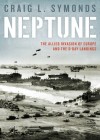The Allied Invasion of Europe and the D-Day Landings
Cambridge Oxford University Press, New York USA, 2014 (First Edition), 422 pp
Hardcover ISBN: 9780199986118
Written By: Craig L Symonds
Reviewed By: Felicity Petrie
Ten years since it was first published, Neptune - The Allied Invasion of Europe and the D-Day Landings remains fresh and relevant. It reviews the D-Day landings and the events leading up to the Allied invasion of Europe in the final stages of the Second World War that is both comprehensive and relevant. Ranging effortlessly from the grand strategic level to the deeply tactical and back again, Symonds covers the political machinations, the military strategic and operational planning, and the details of logistics, geography, weather and industry that influenced the outcomes on the beaches of Normandy, France in 1944.
Despite the breadth and depth of detail covered within the text, this is an enjoyable and engaging read, written in an approachable narrative style accessible to military and history enthusiasts, as well as a lay audience. There is likely to be something new in here for everyone, but especially those interested in the harsh realities of undertaking allied and combined operations. Highly technical concepts are explained without resorting to ‘dumbing down’, and ideas and events are analysed deeply without compromising on readability.
Broadly chronological, Neptune describes with no holds barred how grand strategy gets translated into reality at the front line, in one of the most significant combined military actions in recent history: the Allied invasion of France in July 1944, the first step in Operation Overlord. Although he is an acclaimed and prolific writer on American naval history, Symonds is careful not to make this volume an examination exclusively of the actions of the United States Navy. The contributions made by the Royal Navy, marines, Allied armies and civilians are examined with equal depth and thoroughness. Achievements and mistakes alike from those on all sides are discussed and analysed critically. Political machinations and influences at the highest level are also considered for their part in the overall outcomes. Uniquely for this genre, Symonds begins his review many years before the landings, providing insight into just how long it truly takes to plan and execute a military operation of this almost unimaginable scale.
As implied by the title, Neptune is focused on Operation Neptune, the maritime component contributing to Operation Overlord, but does not do this in isolation from other related events. A particular strength is Symonds’ explanation of the complexities and interdependencies inherent in this truly Allied operation. There are many lessons in the art and science of integration at all levels, and how the coming together of two seemingly similar but actually different cultures bring clashes and compromises, even though everyone is apparently aiming for the same outcome of Allied victory in Europe. There are lessons on the difficulties of practical integration between systems, people, and ships, for example the ability (or lack thereof) of different vessels to carry, transport, unload and support tanks, landing craft, and even people. The challenges faced in integrating army and navy capabilities on land, within the littoral and at sea – and in coordinating headquarters and operational commanders on the front lines – are drawn clearly into the reader's view. Symonds demonstrates with great clarity how, when needs must, human ingenuity and persistence can overcome, often inelegantly and with great risk, these problems of integration. This happened often as the allies attempted to land over a million men on foreign shores using a flotilla of more than six thousand vessels. A ‘mend and make do’ attitude prevailed among so many of the allied soldiers when confronted with obstacles (mines, sunken ships and landing craft, the bodies of their fellow allied service people, logistics shortfalls, political resistance and so much more). This stalwart approach allowed for success in spite of all the challenges.
The importance of logistics at the micro through to the grand scale is a key and often repeated theme in Neptune. While the US Lend-Lease program was in full swing, strategic resources were still scarce and hard fought for. Competition for prioritisation of materiel between the war in the Pacific, with other European theatres, civilian requirements and between the US and the UK created tensions, trade-offs and intractable shortages. In Neptune, Symonds shows that this challenge manifested primarily in a lack of shipping capacity to transport and land the invasion forces, resulting in several delays to D-Day, and initial troop and supply volumes well below those planned for in the opening days of the invasion. Prior to the landings, the need to transport, stage, house, feed and train literally millions of US servicemen in the UK to support preparations placed an enormous drain on the already stretched resources of a country that had been at war already for several years. Neptune offers the reader an eye opening account of the actual requirements of achieving the almost unfathomable scale of this activity, including months of intricate rehearsals for the beach landings. These rehearsals were so realistic that ships offshore were bombarding hotels ashore in the UK that had been requisitioned by the government while troops rehearsed beach landings under incoming live fire.
The details of feeding, fueling and providing ammunition to those ashore, and providing medical aid and recovering the dead and wounded, are also described in graphic and startling detail. Symonds leaves the reader wholly clear that the landing was just the beginning of the problems that needed to be solved for the allied forces. Innovations such as driving landing ships loaded with ammunition onto the beaches have resonance today. They show that under fire, many preconceptions need to be thrown away to achieve the desired outcome.
Symonds provides a comprehensive analysis of planning, and how even the most detailed plans cannot –and do not – cover all contingencies. Operation Neptune demonstrates how the lightest plans can be the most useful, especially when executed with stamina and intelligence, and how personality and the state of mind of key players has as much influence on the outcomes as any other factor, no matter how considered the plans may be. Moreover, despite the years of meticulous planning, weather reveals its hand as the ultimate foil in the massive storm that delayed the landings again at the last moment. Weather also caused havoc for the forces ashore a few days later.
Symonds does not refrain from examining the realities and imperfections that led to the eventual success of the D-Day landings. His approach is unique in that the audience gets to hear the voices and stories of some of the lowest ranking men there, not just the tales of ‘daring do’ of the officer and political classes (although these are also discussed in ample detail). The horrors of seasickness, injury, death and destruction for those on the front line are treated in a matter of fact way, not overly sensationalised but not brushed away either. The reader is left in no doubt as to the bravery and tenacity of all of those involved in Neptune and the D-Day landings under frankly horrific circumstances.
This book is meticulously referenced, using primary and archival sources such as historical papers and oral history collections, as well as the works of others that have come before Symonds in this field. An extensive bibliography also includes introductory notes that are useful for supporting further research. Those involved in amphibious or littoral operations will be shown the absolute complexity required to achieve real outcomes in conflict. Those in industry and maritime support will get a stark illustration of the demands placed on industry at scale, and the time taken even in war to ramp up to a credible and useful level of industrial production. There are lessons on capability design, innovation and novel technologies (hint: they don’t always work the way you want them to even if you did get a chance to test them, but sometimes they do come through with the goods in surprising and effective ways). In short, there is much of value in this text for a wide audience. Its themes and historical examples remain relevant today for a broad audience, presented in a way that is easy to read and understand with no compromise on intellectual rigour.



